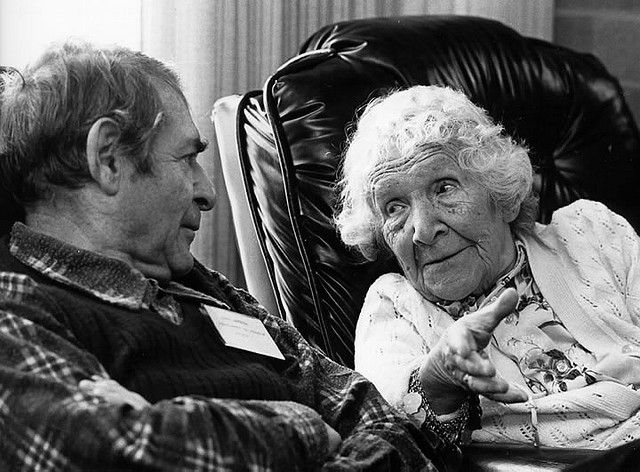
As shootings and school-related torment reach new and frightening levels, the dialogue over bullying has taken center stage in American culture.
And while it took decades to bring the horrors of domestic violence into the public eye, bullied and battered women now have an extensive safety network that includes hotlines, counseling and emergency shelters.
Yet the same cannot be said of a similar, silent epidemic with shocking statistics and brutal realities: elder bullying and abuse.
Despite California’s expertise in elder abuse at the University of California, Irvine – the recognition of its Center of Excellence on Elder Abuse & Neglect gained it headquarters status for the National Center on Elder Abuse – state advocates continue to fight an uphill battle for a similar, coveted tipping point.
“I can’t think of another issue that affects as many people in this country where less is being done,” said elder justice attorney Marie-Therese Connolly, after winning a $500,000 “genius” award from the MacArthur Foundation just over two years ago.
Experts say the reason is simple: older adults just don’t make sympathetic victims.
When Paul Greenwood was assigned to a special District Attorney force in San Diego to prosecute elder abuse in 1991, colleagues wondered what he’d done wrong to earn the dubious assignment. When Greenwood asked law enforcement officials why they didn’t bring elder abuse cases to the D.A. for prosecution, they gave him a similar story. They’re old. They can’t think straight. And it’s a waste of our time.
One in 10 Americans 60 and older suffers from elder abuse. That number skyrockets to 50 percent for those with dementia – cognitive decline that includes Alzheimer’s.
And while elder abuse occurs in many forms – physical, financial, psychological, even sexual – it’s the neglect and physical abuse that produce the most searing mental images: an autopsy finds a latex glove shoved down an elder man’s throat; a woman lies in bed so long she suffers pressure sores with metal bed springs woven into her body.
“We see this all the time,” says Kerry Parker Burnight, who heads the Elder Abuse Forensic Center for both UC Irvine centers. “The question is ‘How many people are suffering and we’ll never know?’”
Meanwhile, financial elder abuse is on the rise faster than any other form, totaling nearly $3 billion a year.
The challenges of combating elder abuse are wildly complex, making its solutions evasive and maddening.
Victims are vulnerable, may be non-verbal, and often suffer from physical and cognitive decline. Abuse often occurs at the hands of family members, friends, or caregivers who can more easily claim innocence or hide. It also takes place in vastly different settings – at home or in various residential care facilities. Finally, there’s typically “poly-victimization” – a complex stew of more than one type of abuse.
“One of the reasons we aren’t where bullying is today is partially because we haven’t been able to figure out how to make one cohesive message,” says Mary Twomey, co-director of the Center of Excellence on Elder Abuse & Neglect.
Americans are filled with denial about the aging process, says Burnight, which creates a separation from older adults as “them,” and blinds us to the ugly truths of abuse.
“I think ageism, coupled with the fear of aging, makes it easier to shut it out,” she adds, fingering another culprit. “If we could stop being brainwashed by the billion-dollar anti-aging industry.”
In an effort to spark momentum on the topic, in 2011 a state blueprint to combat elder abuse was created by the San Francisco-based California Elder Justice Workgroup, which hosted 92 stakeholders from law enforcement, social services, healthcare, advocacy and other arenas.
While the report offers dozens of suggestions on combating elder abuse – including a registry akin to “Megan’s Law” – Twomey says the best solution may come from the domestic violence world.
She says the tipping point in combating at-home violence came when public health officials – who typically focus on health education and disease prevention – rolled up their collective sleeves to address it.
Another focus of the Workgroup’s blueprint is greater cooperation within a fragmented system of law enforcement, healthcare, legislation, courts, and advocacy.
Yet when asked how her well-respected Irvine-based organizations interfaced with the San Francisco-based Workgroup, Burnight answers deferentially.
“I don’t really know what they’re doing.”
And so the battle continues.
Budget cuts like those to the state’s Long-Term Care Ombudsman along with opposition from nursing homes and financial institutions – which fought against mandatory reporting requirements to indicate financial fraud – have slowed progress.
On the bright side, there are pockets of success around the state, and awareness is on the rise.
Burnight’s appearance on CBS’ Dr. Phil show brought the highest traffic ever for elder care resources at the National Center on Elder Abuse. Many health systems today routinely ask older adults whether they are being hurt at home. Successful elder protection courts have been established in Alameda, Contra Costa and Ventura counties. And San Diego’s Greenwood is now recognized as the state’s most tenacious prosecutor of elder abuse crimes.
By 2030 – just over 15 years from now – one in five Californians will be over 65. Those citizens continue to wait anxiously for that coveted tipping point that will move elder abuse from the shadows out into the open.





